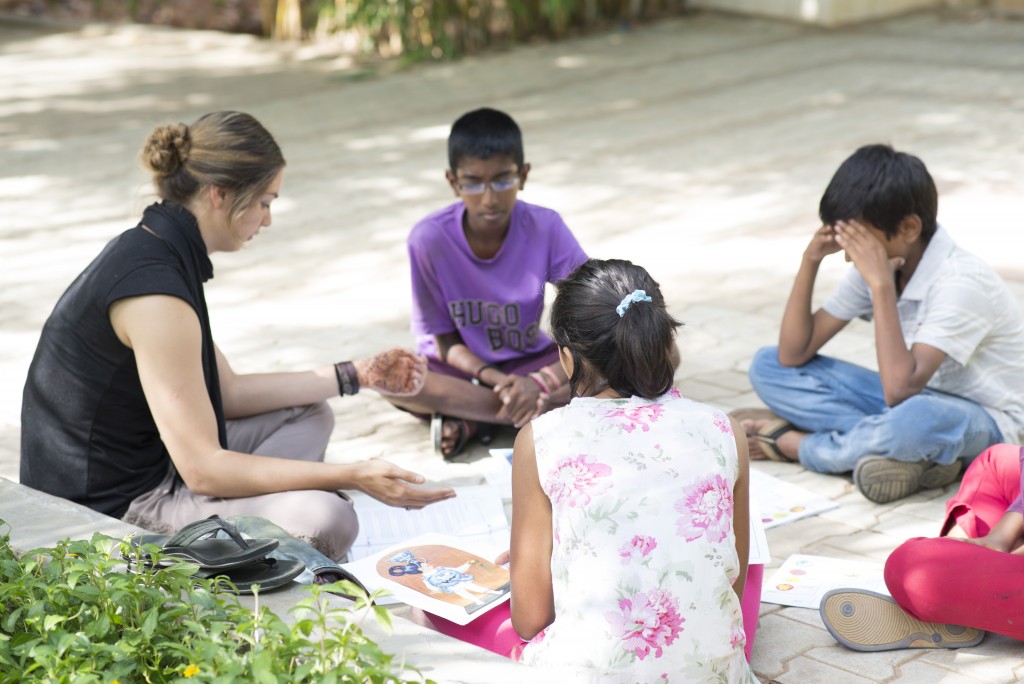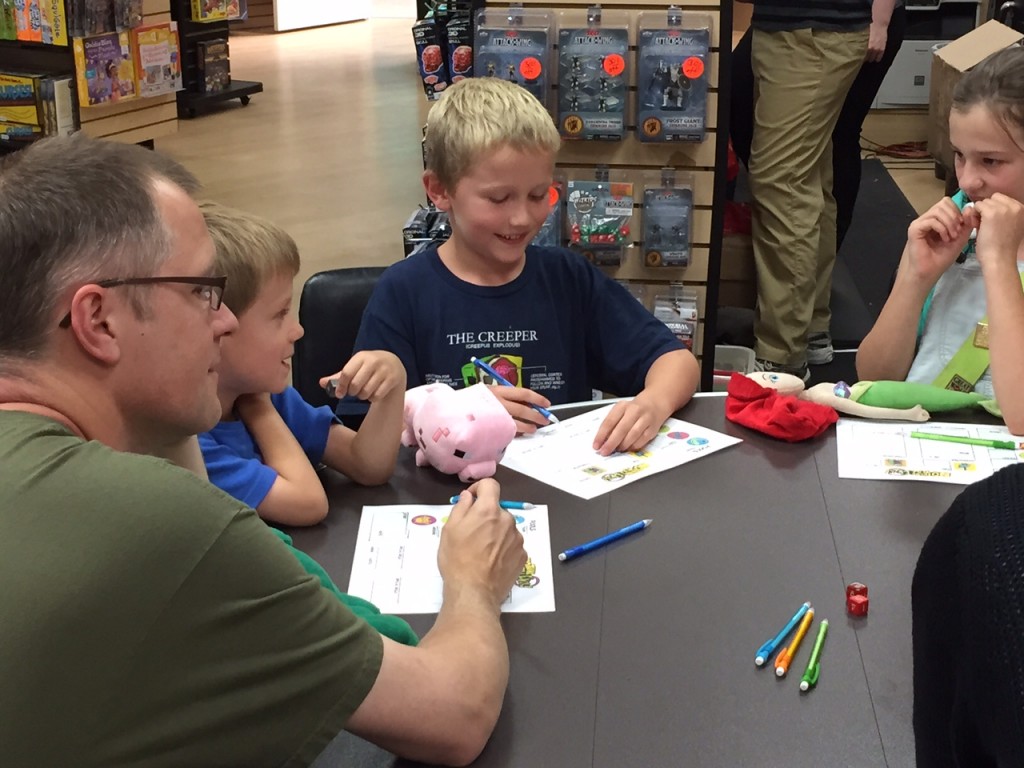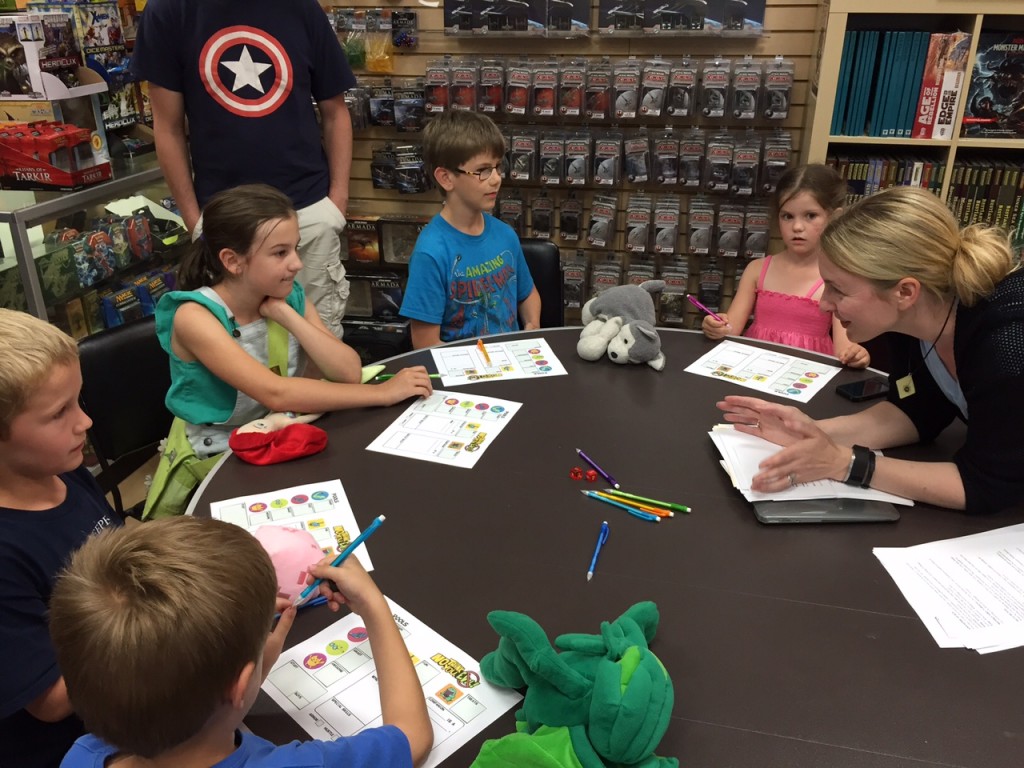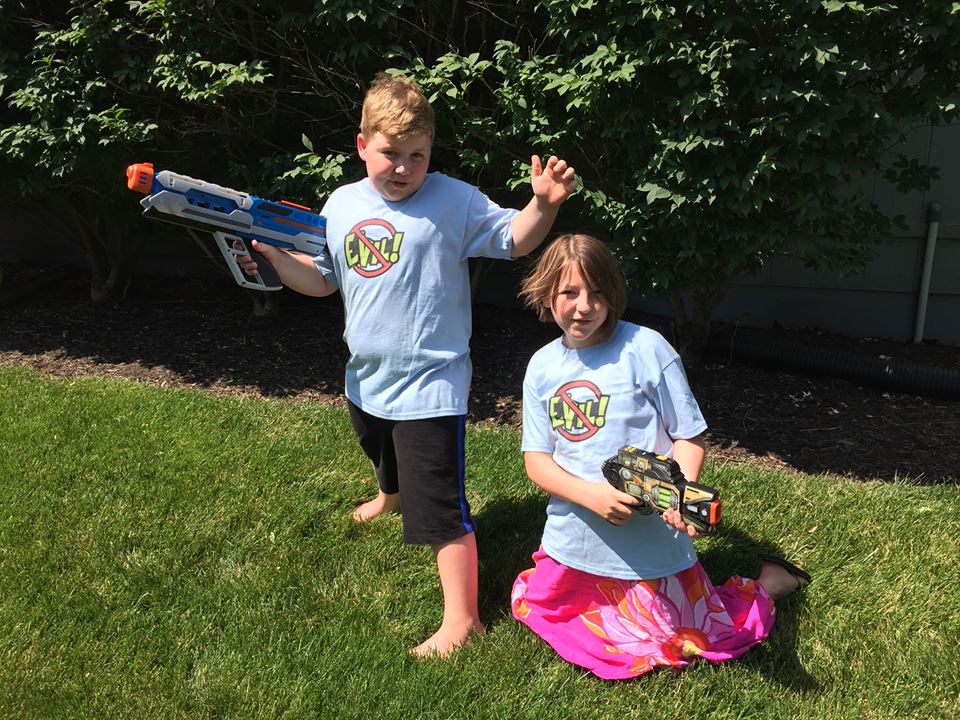MCG is on our End-of-Summer Break this week, so we’re bringing you a web article from the archives: Shanna Germain’s advice on running games for kids! This co-designer of No Thank You, Evil! (coming back into print at the end of the year) has a lot of experience on this topic, which she will bring to Your Best Game Ever! For now, enjoy a taste of that advice with these tips and tricks.

Whitney Beltrán runs No Thank You, Evil! for students in rural India.
Running RPGs for kids can seem daunting at first, but in some ways, it’s actually easier than running for adults. Kids show up at the table ready and willing to play pretend–they’re fantastic at it, in fact, because they do it all the time. So you don’t have to teach them how to become someone else or how to interact with an imaginary world. Instead, much of your job comes down to encouraging their already existing creativity and imagination, while keeping them engaged, focused, and within the boundaries of the rules.
Of course, the No Thank You, Evil! rulebook will have a whole section on running RPGs for the kids in your life, but I also wanted to share a few tips and tricks ahead of time to get you started.
Before you Begin: Getting kids invested and prepared ahead of time can go a long way toward keeping them focused and interested at the table.
- Excite them ahead of time. Get the players invested before the game starts by telling them stories about the world and inviting them to make their characters early. When kids have a handle on the world and know something about it ahead of time, it gets them a way into the adventure. When we told players ahead of time that their characters have an I Gotchyer Back pack that lets them know if something is sneaking up on them, one of the first things they asked when the game started is, “Does my backpack say if anything’s behind me?!”
- Tell them what to expect. Letting players know ahead of time what to expect in terms of time and structure can help them stay focused and keep them on track. It could be time (“We’re going to play until this timer runs out” or “We’re going to play for one hour, until this clock says 3.”) or structure (“First we’re going to create characters. Then, we’ll go on an adventure. An adventure has four parts…”). This is part of the reason we are offering a storybook as a stretch goal for No Thank You, Evil! Not only does it excite players ahead of time, it helps teaches them the structure of an adventure: call for help, figuring out the problem, solving the problem, celebrating!

During the Game: A game’s rules can go a long way toward making an amazing gaming experience, but at some point it’s just you and the players at the table. You are the storyteller, the guide, the scene-setter, and the cat-herder. Here are some ways to keep keeps focused and engaged during the game.
- Invite them to create. Once the players are at the table, ask them questions about the world and their experiences in it. All of the adventures in No Thank You, Evil! advise the GM to ask questions like, “What does your friend Woodlynn the Bee Queen look like?” and “What did you do last time you want to Boom! Laboratories?” Players get excited at the opportunity to offer their vision of what things look like, and when you mash their ideas together, you often get something unexpected. When I asked them what their scientist friend looked like, he “had a big beard that was maybe fake, crazy hair, didn’t wear shoes or socks, had no left foot, was a ghost, and wore a lab coat.” That was way more creative that anything I could have come up with.
- Use props. Invite players to bring tactile objects to the table to represent their character, their companions, and their stuff (within reason, of course. showing up at the table with a bow and arrow isn’t recommended for most players). You can also use all kinds of things to represent the world, the creatures, and the goodies that the players can discover. One thing to be aware of: for kids, size and scale are important. Adult players understand that a miniature dragon is actually a representation of a huge dragon. But we found that when kids had big stuffed plushies for their companions, and we brought out our little dinosaur toys, they thought it was perfectly reasonable to smash the dinosaurs under the foot of their giant stuffed kitten. So if you’re going to bring out creature props, bring out the big creature props (or the smaller companion props).

Running No Thank You, Evil! at Uncles’ Games. Those giant plushies put our little dinosaurs to shame.
Handling Disagreements: If kids are completely split on how to tackle an interaction–say one wants to kill the hungry dinosaur and the other wants to trap it and test its DNA (yes this happened during playtesting)–you can try to tackle that in a few different ways:
- Add a second creature. A second dinosaur comes roaring into the room, a new monster emerges from a cupboard, another skeleton rises out of a grave. The goal here isn’t to make the interaction harder; it’s to allow more interaction opportunities. That way, one group can kill a dinosaur and the other group can trap and test one. I know, I know, the adage is “Don’t split the party,” but with kids, it’s going to happen, so you might as well prepare for it.
- Help the players get creative. Unlike with adult players, who often don’t want to be “helped along” by the GM, young players can sometimes use a little idea boosting. It’s perfectly okay to suggest things like, “You could try to kill the creature and then take its DNA for testing” or “What if you let them sneak in and try to take the DNA first, and if that doesn’t work, then you can whack it with your big stick.”
- Take turns or roll for it. You could go in player order, just like in a combat situation. So the first person attacks the dinosaur, and the second gets to run in and try for some DNA. This creatures some whacky scenarios, while still letting players take their actions. Some of our playtesting GMs also had their players roll for the decision. The person with the highest number got to take the first actio.
- Use a group action. This is a rule that we added to No Thank You, Evil! after playtesting with a number of groups, but it could be used in any game where the players roll. A group action is where everyone agrees on a single action that they all want to do together and then everyone rolls the dice. There’s something that’s exciting enough about getting to roll the dice together that kids seem more likely to come to an agreement (I don’t know the psychology behind this; it’s just what seems to happen at the table). You could make it so that everyone has to roll the Goal number or higher, or that at least half the group does, or some other combination.
Ending the Game. The best piece of advice I have on endings is to finish the game just before players are ready for it to end. Stop too early and they won’t feel like they got enough interactions; end too late and someone will be getting bored or tired. A good ending offers a celebration and the promise of what’s next. Rewards are particularly appreciated, whether they’re in the form of new equipment, levels, treasure, money, or real-world goodies.

Charles Ryan also has some great tips for running games with kids. And, of course, the No Thank You, Evil! rulebook has a whole section devoted to the topic!